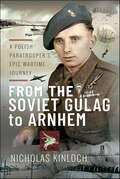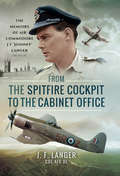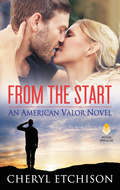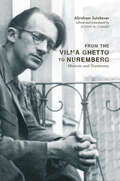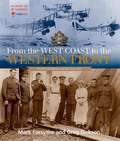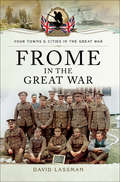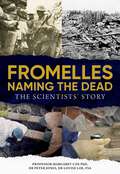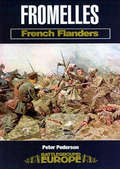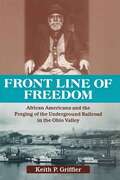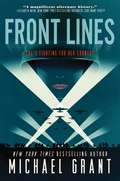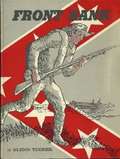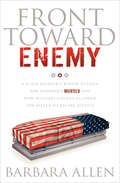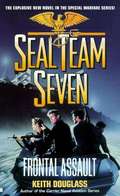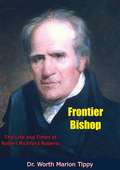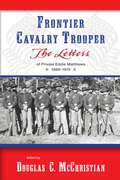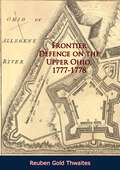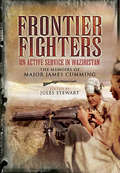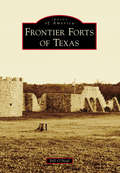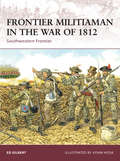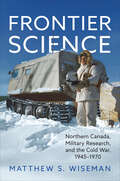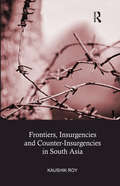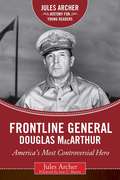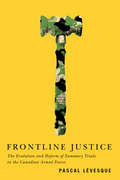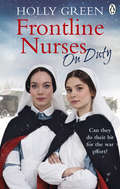- Table View
- List View
From the Soviet Gulag to Arnhem: A Polish Paratrooper's Epic Wartime Journey
by Nicholas KinlochAs featured on TV. The incredible true story of a teenage boy’s perilous journey around the world during World War Two. “A tale of determination and triumph” – Kay Burley, Sky News Stan was aged 15 when war broke out. Over a period of 5 years, he dodged death as he travelled thousands of kilometres from Poland to the UK, via Soviet gulags, Uzbekistan, the Middle East and India. He then trained as a paratrooper in Scotland. He met a local girl and was going to get married, but had to leave her behind when he was dropped into battle at Arnhem. He was trapped behind enemy lines and captured by the Nazis. Only the Dutch underground might be able to help him escape. This thrilling memoir is an inspiring and personal account of a triumph of resilience and courage against great odds.
From the Spitfire Cockpit to the Cabinet Office: The Memoirs of Air Commodore J F 'Johnny' Langer CBE AFC DL
by J. F. LangerAir Commodore John Langer's career has been eventful to say the least. During the Second World War he flew gliders in India in preparation for airborne assaults in Burma, one of the most perilous landscapes to pass across during this time. Post-war, he served on a fighter squadron in Germany and in Malaya, where he was recommended for an AFC. Later on, he commanded No 43 (F) Squadron, the famous 'Fighting Cocks', and was awarded the AFC. As a Group Captain, he commanded RAF Valley and was awarded the CBE. He ended his RAF career as director of Flying Training where he set up the first team of the Red Arrows. By careers end, he had flown fifty-six different types of aircraft.On leaving the RAF, he became the Civil Aviation Security Adviser to the UK Government, serving for eight years as a Crown Servant and a further seven years as a consultant. He was a frequent advisor to the Cabinet Office Briefing Room 'A' (Cobra), consulting with members of the cabinet on national and international aviation matters in the wake of a series of security and terrorist emergencies. In 1993 he was appointed Duty Lieutenant for Greater London, with responsibilities for the borough of Hillingdon, location of both Heathrow and Northolt airport. He looked after members of the Royal Family in their departures from these airports and became a good friend of Princess Diana, chaperoning her on a number of solo outings. Interesting details relating to some of their exchanges are included here. This is a unique autobiography, taking in a vast spectrum of events and experiences. It is also an important record of political, aviation and social history and should appeal to enthusiasts of all these areas of interest.
From the Start: An American Valor Novel
by Cheryl EtchisonThe Rangers of the 1st/75th fight hard, train hard and play hard. They are physically strong and mentally tough, disciplined and courageous. But all their military training hasn't prepared them for falling in love.For many women, Ranger Battalion Surgeon Michael MacGregor is the ideal man. He's far better than average looking, a generous tipper, not to mention an officer and a doctor. So when he encounters a woman resistant to his charms, he finds himself... intrigued.Kacie Morgan has had her fill of arrogant military men since the last one left her with a shattered heart and one heck of a career rut. Now, with her prestigious fellowship starting in the fall, all she has to do is survive the summer--and her little sister's wedding. When an ill-fitting bridesmaid dress has Kacie wanting to temporarily shake things up in her carefully planned life, she knows just the man to call. They agree to a no-strings, summer fling, although it isn't long before Michael wants Kacie for forever.But to win her heart, he'll have to confront the nightmares from his past if they're to have any chance at a future.
From the Vilna Ghetto to Nuremberg: Memoir and Testimony
by Abraham SutzkeverIn 1944, the Yiddish poet Abraham Sutzkever was airlifted to Moscow from the forest where he had spent the winter among partisan fighters. There he was encouraged by Ilya Ehrenburg, the most famous Soviet Jewish writer of his day, to write a memoir of his two years in the Vilna Ghetto. Now, seventy-five years after it appeared in Yiddish in 1946, Justin Cammy provides a full English translation of one of the earliest published memoirs of the destruction of the city known throughout the Jewish world as the Jerusalem of Lithuania.Based on his own experiences, his conversations with survivors, and his consultation with materials hidden in the ghetto and recovered after the liberation of his hometown, Sutzkever’s memoir rests at the intersection of postwar Holocaust literature and history. He grappled with the responsibility to produce a document that would indict the perpetrators and provide an account of both the horrors and the resilience of Jewish life under Nazi rule. Cammy bases his translation on the two extant versions of the full text of the memoir and includes Sutzkever’s diary notes and full testimony at the Nuremberg Trials in 1946. Fascinating reminiscences of leading Soviet Yiddish cultural figures Sutzkever encountered during his time in Moscow – Ehrenburg, Yiddish modernist poet Peretz Markish, and director of the State Yiddish Theatre Shloyme Mikhoels – reveal the constraints of the political environment in which the memoir was composed.Both shocking and moving in its intensity, From the Vilna Ghetto to Nuremberg returns readers to a moment when the scale of the Holocaust was first coming into focus, through the eyes of one survivor who attempted to make sense of daily life, resistance, and death in the ghetto.A Yiddish Book Center Translation
From the West Coast to the Western Front
by Greg Dickson Mark ForsytheIt has often been observed that the First World War jolted Canada into nationhood, and as Mark Forsythe and Greg Dickson show in this compelling book, no province participated more eagerly in that transformation or felt the aftershock more harshly than British Columbia. In From the West Coast to the Western Front, Forsythe, host of CBC Radio's mid-day show BC Almanac, marks the 100th anniversary of World War I by teaming with historian Greg Dickson and the ever resourceful BC Almanac audience to compile a sweeping portrayal of that crucial chapter of BC history.Of the 611,000 Canadians who fought for King and Country,55,570 were from British Columbia-the highest per capita rate of enlistment in the country. Of that contingent, 6,225 died in battle, a critical loss to a fledgling province of barely 400,000.Compiling stories, artifacts and photos sent in by BC Almanac listeners from across the province, this volume tells of submarine smuggling, bagpipes lost on the battlefield and of the ongoing struggles by soldiers who made it home. It tells of battles that set records for mass death amid conditions of unequalled squalor, but also of the heroism of front-line nurses and soldiers like George Maclean, a First Nations man from the Okanagan, who won the Distinguished Conduct Medal.By turns devastating, harrowing, insightful and miraculous, these stories reveal much about the spirit and resilience of a people who survived one of history's greatest disasters to build the province we have today.
Frome in the Great War (Your Towns & Cities in the Great War)
by David LassmanThe Somerset town of Frome is something of a paradox. Since being founded at the end of the sixth century its fiercely independent nature has been unchanging. A nature which, as one columnist has noted: 'seems to have revolved around the eminently sensible attitude of To hell with national events! We will stay as we are.' And yet a century ago, when called on by its country to do its duty in the Great War, it rose to the task admirably. Men from Frome and the surrounding area experienced action in all the theatres of war that the global conflict encompassed, and they took part in the numerous battles and campaigns, on land and at sea, that have become synonymous with that conflict: Ypres, Gallipoli, Jutland, the Somme. At the same time, its civilian population received a special commendation after the war for its effort throughout it. However, the towns contribution did not stop there, as many of the returning soldiers helped to create several of the national and international monuments and memorials that would pay eternal tribute to their comrades who fell on the fields of Flanders and elsewhere. Using letters, diaries, photographs, newspaper reports and eyewitness accounts, along with other archive material, local historian and author David Lassman has assembled the story of Frome during the Great War; a story which charts the transformation of this once rich and powerful textile centre and manufacturing town, along with its people, through the life-changing events of 1914 to 1918
Fromelles – Naming the Dead: The Scientists' Story
by Professor Margaret Cox Dr Peter Jones PhD Dr Louise LoeThis is the extraordinary story of the engagement between 250 young Australians, who enlisted in 1915 and died in the Battle of Fromelles of 1916, their families, and three British scientists. In 2009, the bodies of these 250 soldiers were excavated by Oxford Archaeology. Among them were the Wilson brothers who, with their comrades were subsequently reburied in individual marked graves in the new cemetery in Fromelles village. The Battle of Fromelles needs no introduction, nor do the losses sustained. Here we focus on 166 of the 250 soldiers who were excavated from six mass graves adjacent to Pheasant Wood in 2009 and who have since been identified. Each has his own story to tell as does his family. We explore aspects of these lost lives while telling the story of their recovery and identification. This is the story of how these lost soldiers were excavated and identified. It is told by the scientists who led the excavation, the anthropological and DNA analyses, and the identification process. It is their story of involvement with and commitment to this fascinating project, in which many combined decades of professional experience were pooled to help achieve a fitting final resting place, names restored, for these brave men, and belated solace for their families. Much has been written about the Battle of Fromelles, the missing soldiers, their families&’ quests to restore their identities and the discovery and excavation of the graves. This book tells a new story. it is the scientist&’s story behind naming the Fromelles&’ dead.
Fromelles: French Flanders (Battleground Europe)
by Peter PedersenHistorian Peter Pedersen examines the World War I battle on the Western Front that decimated an Australian regiment in Fromelles: French Flanders.The attack at Fromelles is significant for a number of reasons. It was the Australians’ first major operation on the Western Front and pitted them against a part of the German line that was an object lesson in the siting of a defense. Before the battle, the Australian Gallipoli veterans had airily dismissed the fighting in the new theater as “pleasant”. After it, they said grimly that Anzac was “a picnic” compared to France. Fromelles came as a terrible shock and was a foretaste of things to come. Both the genesis and aftermath of the operation were controversial. The objectives and the tactics employed to achieve them were changed several times and the sufficiency of resources vigorously debated. After the war, the British and Australian Official Historians argued as to how the battle should be interpreted. Most of the correspondence that accompanied their exchange of drafts has not been published. Peter Pedersen’s thorough account of the battle explores the genesis of the operation through the aftermath covering this monumental moment in World War I history.
Front Line Of Freedom: African Americans And The Forging Of The Underground Railroad In The Ohio Valley (Ohio River Valley Ser.)
by Keith P. GrifflerThe Underground Railroad, an often misunderstood antebellum institution, has been viewed as a simple combination of mainly white "conductors" and black "passengers." Keith P. Griffler takes a new, battlefield-level view of the war against American slavery as he reevaluates one of its front lines: the Ohio River, the longest commercial dividing line between slavery and freedom. In shifting the focus from the much discussed white-led "stations" to the primarily black-led frontline struggle along the Ohio, Griffler reveals for the first time the crucial importance of the freedom movement in the river's port cities and towns. Front Line of Freedom fully examines America's first successful interracial freedom movement, which proved to be as much a struggle to transform the states north of the Ohio as those to its south. In a climate of racial proscription, mob violence, and white hostility, the efforts of Ohio Valley African Americans to establish and maintain communities became inextricably linked to the steady stream of fugitives crossing the region. As Griffler traces the efforts of African Americans to free themselves, Griffler provides a window into the process by which this clandestine network took shape and grew into a powerful force in antebellum America.
Front Lines
by Michael GrantPerfect for fans of The Book Thief and Code Name Verity, New York Times bestselling author Michael Grant unleashes an epic, genre-bending, and transformative new series that reimagines World War II with girl soldiers fighting on the front lines.World War II, 1942. A court decision makes women subject to the draft and eligible for service. The unproven American army is going up against the greatest fighting force ever assembled, the armed forces of Nazi Germany.Three girls sign up to fight. Rio Richlin, Frangie Marr, and Rainy Schulterman are average girls, girls with dreams and aspirations, at the start of their lives, at the start of their loves. Each has her own reasons for volunteering: Rio fights to honor her sister; Frangie needs money for her family; Rainy wants to kill Germans. For the first time they leave behind their homes and families--to go to war.These three daring young women will play their parts in the war to defeat evil and save the human race. As the fate of the world hangs in the balance, they will discover the roles that define them on the front lines. They will fight the greatest war the world has ever known.
Front Rank [Illustrated Edition]
by Glenn TuckerIncludes more than 20 illustrationsFamed Civil War historian Glen Tucker was commissioned by the North Carolina Confederate Centennial Commission to write a short portrait of the men and battles that the soldiers from North Carolina fought under the Stars and Bars. Illustrated beautifully throughout by Bill Ballard, the author takes the reader on to the battlefields of the Civil War and through his vivid vignettes records the immortal deeds of the North Carolinians from Manassas to the last shot at Appomattox.
Front Toward Enemy: A Slain Soldier's Widow Details Her Husband's Murder and How Military Courts Allowed the Killer to Escape Justice
by Barbara AllenA slain soldier&’s widow details her husband&’s murder by a fellow soldier . . . and exposes how the US military courts allowed the killer to escape justice. June 7, 2005. A sandstorm obscured what light lingered in Iraq&’s nighttime sky as Staff Sergeant Alberto Martinez tied a claymore mine to a window grate. On the other side of the window was Lieutenant Louis Allen, a husband and father of four young boys, and his good friend and Commanding Officer Captain Phillip Esposito, a West Point graduate and father of a baby girl. The men were engaged in a board game, unwinding after a hard day, when without warning the window exploded. More than seven hundred steel ball bearings erupted from the mine and hurtled inward with lethal force, obliterating everything in their kill zone. Martinez was arrested and tried for the murders. But the military judicial system failed, and the killer was set free. How can American soldiers be at risk on their own base, among their fellow soldiers? Could these murders have been prevented? Will it happen again? How can the military&’s judicial system have failed so drastically? What was the government hiding from the slain soldiers&’ families? This book is a personal and factual behind-the-scenes account of a case that is to the military judicial system what the O. J. Simpson case is to the civilian judicial system.
Frontal Assault (Seal Team Seven, #10)
by Keith DouglassMurdock and his SEAL team find themselves right in the middle of the fight. They're going to show Saddam that he's not the only one who can destroy a country from within.
Frontier Bishop: The Life and Times of Robert Richford Roberts
by Dr Worth Marion TippyThis book, written by Dr. Worth Marion Tippy in 1958, is a biography of Robert Richford Roberts (1778-1843), an American Methodist Circuit Rider, Pastor, Presiding Elder, and the first married man in America to serve as Bishop of the Methodist Episcopal Church, elected in 1816.Born in Frederick County, Maryland, his family were communicants of The Church of England. In 1785, they moved to the Ligonier Valley in Westmoreland County, Pennsylvania, where Roberts united with the M.E. Church when he was fourteen years old. Until he was twenty-one, his was a thoroughly frontier existence, with few books and quite simple habits. Despite becoming one of the “foremost religious leaders of his time,” he remained a frontiersman to the day of his death in 1843.“Long after he became a bishop he liked to follow deer in the forest. When he was free, being now a bishop, to live where he chose, he established his episcopal residence in what was then wilderness of the hill country of southern Indiana. Here, in utmost seclusion, he lived for the next quarter century, at first under most primitive conditions. From this isolated place he left on horseback on his amazing episcopal journeys to all parts of the nation, returning after long absences to work on his lands.”Dr. Tippy tells of Bishop Roberts’ move from his native Maryland to the then-frontier of western Pennsylvania, where his father had secured four hundred acres of land in the Ligonier Valley fifty miles east of Pittsburgh, and where the young Roberts would go on to experience the hardships and adventures of migrants before and after him—experiences which “better prepared for the leadership which came to him so early in life.”An invaluable read.
Frontier Cavalry Trooper: The Letters of Private Eddie Matthews, 1869–1874
by Douglas C. McChristianDuring his five years in the army, Private Edward L. Matthews wrote a series of exceptionally detailed and engaging letters to his family back home in Maryland describing his life in the Arizona and New Mexico Territories. Eddie Matthews&’s letters, published here for the first time, provide an unparalleled chronicle of one soldier&’s experiences in garrison and in the field in the post–Civil War Southwest.Eddie&’s letters record a vivid chronicle of day-to-day life in the frontier regulars. Included are operational details in his company, candid observations of people and places, intimate views of frontier society, and personal opinions that probably would have been forgotten or moderated had he recorded his experiences later in life. More subtle are his valuable references to the state of transportation and communication in the Southwest during the early 1870s. Matthews probably did not realize until later years that he was not only a witness to the nation&’s rapid westward expansion, but was himself a tiny cog in the machinery that made it possible.
Frontier Defence on the Upper Ohio, 1777-1778
by Reuben Gold ThwaitesBut the barbaric enemy facing the frontier differed greatly from the well-equipped, well-drilled professional army from Europe that confronted the armed men of the tidewater. The stealthy foes of the border aimed their heaviest blows at the homes, wives, and children of the settlers; no life was safe from them, no person secure. Through long and bitter experience, the backwoodsmen had come to understand the art of defense by concentration within neighborhood blockhouses and log forts. But a new danger presented itself. The Indians were now guided and stimulated by the nation’s white enemies, so that to their native cunning were added the superior intelligence and more astute methods of the English. The situation soon became desperate.The British authorities at Detroit were especially active in urging the Indians to war against the Americans. Permissory orders to that effect were received by Lieutenant-Governor Hamilton early in June, 1777. With consummate skill he roused the barbarians to frenzy; under his stimulus they prepared to hurl themselves upon the American frontier. The invading parties were provided by Hamilton with proclamations prepared both by Governor Carleton and himself, calling on the Western inhabitants to submit to King George and take refuge within the British posts, where a land bounty would be given them for loyal service. This project was adroitly devised to mingle terror and mercy, in the hope that the colonists’ rebellion would speedily be crushed on the Western borders; and that the Easterners, finding themselves between two fires, would be obliged to yield. The effect of these proclamations, scattered by Indian raiders throughout the American backwoods settlements, was considerable. In some cases they were suppressed by American officers, but the Loyalist disaffection in the trans-Alleghany is largely attributable to this source.
Frontier Fighters: The Memoirs of Major James Cumming
by Walter CummingsThese are fascinating memoirs of a British officer who fought the legendary Pathan tribesmen of the Northwest Frontier, right up to the beginning of WW2. He describes desperate battles against this highly skilled and ruthless enemy. Pathan atrocities were commonplace and no prisoners were taken.Cummings served in two Frontier units, the South Waziristan Scouts and the Corps of Guides. Waziristan, then the home of Wazirs and Mahsuds, the most war like of Pathan tribes, is today sanctuary for Al Qaeda and Taliban terrorists. Frontier Fighters describes the closing stages of Britains imperial presence on the subcontinent. Yet beside the pig sticking, polo and hunting, there was great excitement danger and gallantry. A unique bond existed between the British and their native troops. Paradoxically Cummings went on to command a Pathan regiment in North Africa in WW2.
Frontier Forts of Texas (Images of America)
by Bill O'NealWith its vast size and long frontier period, Texas was the scene of more combat events between Native American warriors and Anglo soldiers and settlers than any other state or territory. The US Army, therefore, erected more military outposts in Texas, a tradition begun by Spanish soldados and their presidios. Settlers built blockhouses and even stockades, the most famous of which was Parker's Fort, the site of an infamous massacre in 1836. Successive north to south lines of Army forts attempted to screen westward-moving settlers from war parties, while border posts stretched along the Rio Grande from Fort Brown on the Gulf of Mexico to Fort Bliss at El Paso del Norte. Texas was the site of the first US Cavalry regiment employed against horseback warriors, as well as the experimental US Camel Corps. From Robert E. Lee to Albert Sidney Johnston to Ranald Mackenzie, the Army's finest officers served out of Texas forts, and 61 Medals of Honor were earned by soldiers campaigning in the Lone Star State.
Frontier Militiaman in the War of 1812
by Adam Hook Ed Gilbert"He who relies on militia leans upon a broken cane." (George Washington)Osprey's survey of militiamen of the War of 1812. The great military effectiveness of semi-trained local militia is one of the enduring myths of American military history. In this book Ed Gilbert reveals the truth behind this myth. Quoting from memoirs of men like Sam Dale, Sam Houston, and rare histories, he sheds light on who these frontier men actually were. He chronicles how militiamen, ranging from hard-working farmers to politicians like Davy Crockett, were transformed through hard campaigning, fierce combat, and Andrew Jackson's equally fierce discipline, into a formidable fighting force. Contemporary illustrations and artwork depict the rough life on campaign and the uniforms worn by the militia. He details how they fought and won the crucial battle of Horseshoe Bend, and how finally on the swampy Plains of Chalmette a scratch force of State Militias, Federal Regulars, US Marines, and Jean Lafitte's mercenary pirates inflicted a stunning defeat on General Pakenham's forces, opening up the western frontier for the new nation.
Frontier Science: Northern Canada, Military Research, and the Cold War, 1945–1970
by Matthew WisemanBetween 1945 and 1970, Canada’s Department of National Defence sponsored scientific research into the myriad challenges of military operations in cold regions. To understand and overcome the impediments of the country’s cold climate, scientists studied cold-weather acclimatization, hypothermia, frostbite, and psychological morale for soldiers assigned to active duty in northern Canada. Frontier Science investigates the history of military science in northern Canada during this period of the Cold War, highlighting the consequences of government-funded research for humans and nature alike. The book reveals how under the guise of “environmental protection” research, the Canadian military sprayed pesticides to clear bushed areas, used radioactive substances to investigate vector-borne diseases, pursued race-based theories of cold tolerance, and enabled wide-ranging tests of newly developed weapons and equipment. In arguing that military research in northern Canada was a product of the Cold War, Matthew S. Wiseman tackles questions of government power, scientific authority, and medical and environmental research ethics. Based on a long and deep pursuit of declassified records, archival sources, and oral testimony, Frontier Science is a fascinating new history of military approaches to the human-nature relationship.
Frontiers, Insurgencies and Counter-Insurgencies in South Asia
by Kaushik RoyThis book uses cross-cultural analysis across Eurasia and Afro-Asia to trace the roots of contemporary border disputes and insurgencies in South Asia. It discusses the way frontiers of British India, and consequently the modern states of India and Pakistan, were drafted through negotiations backed up by organized violence, showing how this conce
Frontline General: America's Most Controversial Hero (History for Young Readers)
by Jules Archer Iain C. MartinAt twenty-six Douglas MacArthur was military aide to President Theodore Roosevelt, and his courageous leadership of the Rainbow Division in World War I made him a general. At the same time, his reluctance to heed any authority but his own gained him a reputation of arrogance and insubordination that was to shadow his entire career.As MacArthur helped guide defeated Japan to democracy, it was remarked that he himself tolerated no democratic questioning of his commands. When he was summoned from Japan to take command of the desperately beleaguered forces in Korea, the conflict between duty and pride brought his career to a dramatic conclusion. With brilliant generalship he saved his army from defeat, only to be removed from his post when he refused to obey the president himself. Douglas MacArthur’s deeds were of heroic proportion, but he is, and will continue to be, one of America’s most controversial figures.
Frontline Justice: The Evolution and Reform of Summary Trials in the Canadian Armed Forces (Human Dimensions in Foreign Policy, Military Studies, and Security Studies #7)
by Pascal LévesqueCompared with its civilian counterpart – which struggles with delays and uncertain results – summary military justice is efficient. From offence until outcome, 90 per cent of cases are dealt with in less than ninety days. The other side of the coin is that there is no right to representation by defence counsel, no transcript produced, and no appeal to a judge. Nine times out of ten, individuals are found guilty. For service members, consequences can include fines, reductions in rank, confinement, and sentences of up to thirty days in military jail, sometimes with a criminal conviction. Addressing important gaps in legal literature, Frontline Justice sets out to examine summary justice in Canada's military and to advocate for reform. Pascal Lévesque describes the origins, purposes, and features of the summary trial system in the Canadian Armed Forces. He then analyzes the system's benefits and flaws and the challenges it faces in maintaining discipline while respecting the Canadian Charter of Rights and Freedoms. Lévesque determines that troubling aspects of the system, including the fact that lower and higher ranks are dealt with and punished differently, are clear indicators of a need for change. Criticizing current legislation, the book takes into account the latest developments in military law and jurisprudence to make concrete recommendations for an alternative model of military justice. A thought-provoking and balanced analysis, Frontline Justice seeks to remedy some of the more unfair and arcane proceedings of the Canadian military's summary trial system.
Frontline Justice: The Evolution and Reform of Summary Trials in the Canadian Armed Forces (Human Dimensions in Foreign Policy, Military Studies, and Security Studies)
by Pascal LévesqueCompared with its civilian counterpart - which struggles with delays and uncertain results - summary military justice is efficient. From offence until outcome, 90 per cent of cases are dealt with in less than ninety days. The other side of the coin is that there is no right to representation by defence counsel, no transcript produced, and no appeal to a judge. Nine times out of ten, individuals are found guilty. For service members, consequences can include fines, reductions in rank, confinement, and sentences of up to thirty days in military jail, sometimes with a criminal conviction. Addressing important gaps in legal literature, Frontline Justice sets out to examine summary justice in Canada's military and to advocate for reform. Pascal Lévesque describes the origins, purposes, and features of the summary trial system in the Canadian Armed Forces. He then analyzes the system's benefits and flaws and the challenges it faces in maintaining discipline while respecting the Canadian Charter of Rights and Freedoms. Lévesque determines that troubling aspects of the system, including the fact that lower and higher ranks are dealt with and punished differently, are clear indicators of a need for change. Criticizing current legislation, the book takes into account the latest developments in military law and jurisprudence to make concrete recommendations for an alternative model of military justice. A thought-provoking and balanced analysis, Frontline Justice seeks to remedy some of the more unfair and arcane proceedings of the Canadian military's summary trial system.
Frontline Nurses On Duty: A moving and emotional historical novel (Frontline Nurses Series #2)
by Holly GreenCan they do their bit for the war effort?A gripping historical saga based on a true story, following wartime nurses during the First World War. Perfect for fans of Lizzie Page’s The War Nurses, Donna Douglas’s The Nightingale Nurses and Margaret Dickinson’s The Poppy Girls.When war is declared in 1914, Leonora Malham Brown and her best friend Victoria, head to Calais to volunteer with the First Aid Nursing Yeomanry. But Leonora is torn between doing her duty and love. Determined to see her sweetheart, Colonel Malkovic, again she soon decides to return to the Front. Leonora quickly loses hope of ever finding Sasha as she gets caught up in the chaos of the battlefields. Finding herself alone and in danger, she must use all her nursing training if she is to return home safely…A moving emotional wartime saga about brave nurses on the battlefield, based on an amazing true story. ________________________________Make sure you've read all the books in the Frontline Nurses series:1. Frontline Nurses2. Frontline Nurses On Duty3. Secrets of the Frontline NursesAnd don't miss Holly Green's new series set in a Liverpool Workhouse:1. Workhouse Orphans2. Workhouse Angel3. Workhouse Nightingale4. Workhouse Girl
